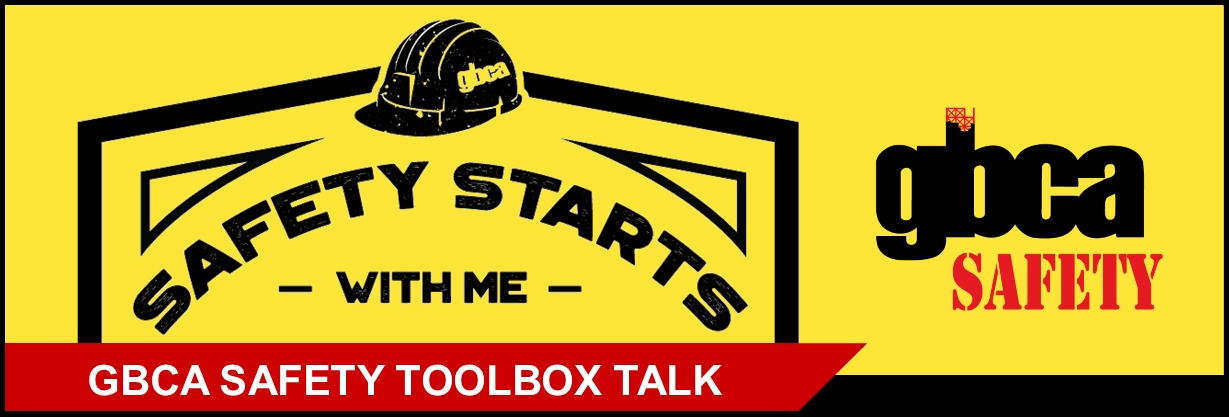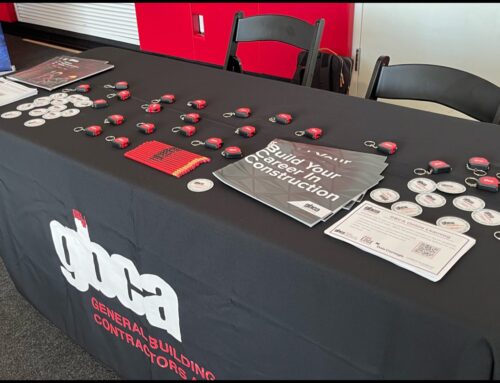This GBCA Safety Toolbox Talk discusses the chain of infection and how diseases such as COVID-19 spread. This toolbox talk works to explain how COVID-19 response and recommended safety protocols are designed, and why they should work (Updated November 11, 2020). Click below to download the Toolbox Talk as a handout (includes Sign-In Sheet).
COVID-19: The Chain of Infection
The risk of contracting and spreading COVID-19 increases as the weather gets colder and people spend more time indoors. The Chain of Infection, a model used in Infection Control Risk Assessment training for hospital workers, explains how diseases spread and identifies points at which to stop diseases from spreading. This toolbox talk describes the Chain of Infection model, and uses it to explain COVID-19 response, as well as COVID-19 recommended job site protocols.

THE CHAIN OF INFECTION MODEL
THE PATHOGEN:
The virus or disease-causing agent.
THE RESERVOIR:
Where the pathogen can live and reproduce, i.e. the infected person.
THE PORTAL OF EXIT:
The way the pathogen leaves a reservoir to then be spread to a new reservoir.
THE MODE OF TRANSPORTATION:
How the pathogen moves from one reservoir to a new reservoir.
THE PORTAL OF ENTRY:
How the pathogen enters a new reservoir.
THE SUSCEPTIBLE HOST:
A non-immune, immune deficient, or immunocompromised person who can become the new reservoir.
The goal of medical professionals and scientists is to stop the chain at as many points as possible.

APPLYING COVID-19 EXAMPLE TO THE CHAIN OF INFECTION MODEL
THE PATHOGEN:
SARS-CoV-2 (the virus causing COVID-19).
THE RESERVOIR:
Infected humans.
THE PORTAL OF EXIT:
The respiratory system, mainly the nose and mouth.
THE MODE OF TRANSPORTATION:
Respiratory droplets that are exhaled while breathing, talking, sneezing, coughing, and singing. These droplets can be either airborne or land onto surfaces.
THE PORTAL OF ENTRY:
Primarily the respiratory system (mouth, nose) or eyes.
THE SUSCEPTIBLE HOST:
COVID-19 is a novel/new virus without an FDA-approved vaccine or treatment. All humans are considered highly susceptible.
RECOMMENDED COVID-19 RESPONSE
The following are some recommended safety measures to prevent the spread of COVID-19. Each of these actions can stop COVID-19 at different points of the Chain of Infection (see after the list).
- Maintain a distance of at least 6 feet from others as much as possible.
- Wear a face covering, such as a cloth face mask. Make sure your nose and mouth are covered. Even if you are not yet symptomatic, or asymptomatic, the mask will reduce the potential for spread of the disease.
- Cough or sneeze into a tissue and throw the used tissue into the trash.
- If you sneeze or cough into your mask to the point that it gets wet, change your mask.
- Avoid touching your face, especially your eyes, nose, and mouth, with unwashed hands.
- Wash your hands often with soap and water for at least 20 seconds, and especially after touching things. If soap and water are not available, liberally use an alcohol-based hand sanitizer until you can wash your hands.
- Clean and disinfect frequently touched objects and surfaces.
- Avoid close contact with people who are sick.
- Stay home when you’re sick. Individuals with COVID-19 should isolate for at least 10 days. Individuals possibly infected with COVID-19 should quarantine for at least 14 days.
- When a vaccine is developed and made available, get vaccinated.



HOW TO STOP THE COVID-19 CHAIN OF INFECTION
COVID-19 can be stopped at almost every point of the Chain of Infection. Here, we apply the recommended COVID-19 safety measures to the Chain of Infection model (note that some actions appear more than once.)
STOP COVID-19 AT THE RESERVOIR:
- Avoid close contact with people who are sick.
- Stay home when you’re sick. Individuals with COVID-19 should isolate for at least 10 days. Individuals possibly infected with COVID-19 should quarantine for at least 14 days.
- Maintain a distance of at least 6 feet from others as much as possible.
STOP COVID-19 AT THE PORTAL OF EXIT:
- Wear a face covering, such as a cloth face mask. Make sure your nose and mouth are covered. Even if you are not yet symptomatic, or asymptomatic, the mask will reduce the potential for spread of the disease.
- Cough or sneeze into a tissue and throw the used tissue into the trash.
- If you sneeze or cough into your mask to the point that it gets wet, change your mask.
STOP COVID-19 AT THE MODE OF TRANSPORTATION:
- Wear a face covering, such as a cloth face mask. Make sure your nose and mouth are covered.
- Maintain a distance of at least 6 feet from others as much as possible.
- Clean and disinfect frequently touched objects and surfaces.
- Wash your hands often with soap and water for at least 20 seconds, and especially after touching things. If soap and water are not available, liberally use an alcohol-based hand sanitizer until you can wash your hands.
STOP COVID-19 AT THE PORTAL OF ENTRY:
- Wash your hands often with soap and water for at least 20 seconds, and especially after touching things. If soap and water are not available, liberally use an alcohol-based hand sanitizer until you can wash your hands.
- Avoid touching your face, especially your eyes, nose, and mouth, with unwashed hands.
- Avoid close contact with people who are sick.
- Maintain a distance of at least 6 feet from others as much as possible.
- Wear a face covering, such as a cloth face mask. Make sure your nose and mouth are covered.
STOP COVID-19 AT THE SUSCEPTIBLE HOST:
- Stay home when you’re sick. Individuals with COVID-19 should isolate for at least 10 days. Individuals possibly infected with COVID-19 should quarantine for at least 14 days.
- Avoid close contact with people who are sick.
- Maintain a distance of at least 6 feet from others as much as possible.
- Wear a face covering, such as a cloth face mask, when near others. Even if you are not yet symptomatic, or asymptomatic, the mask will reduce the potential for spread of the disease.
- When a vaccine is developed and made available, get vaccinated.
Remember to record the attendees of your toolbox talk!





